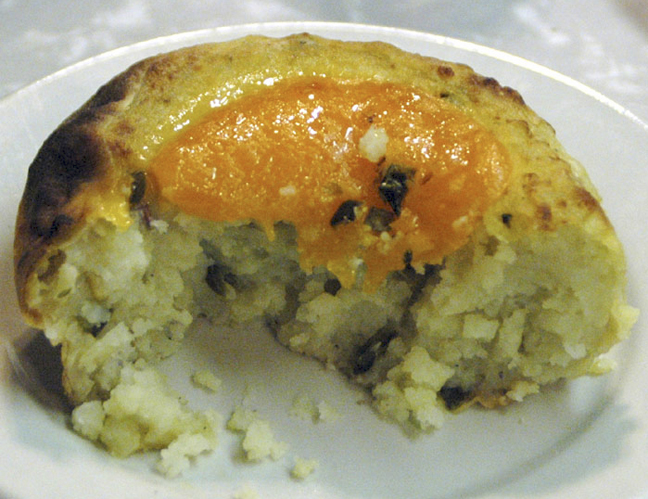Knishes, Cuban style

By Jennifer Stempel, JTA
When I think of knishes, I think of New York Jewish deli-style discs of creamy potato or savory meat enveloped by a flaky crust. Potato knishes are my favorite because they act as a vehicle for as much good, grainy mustard as I see fit.
 In Cuba, and many other Caribbean countries, green plantains are often used interchangeably with potatoes as the starch component of a meal, so adding them to a knish felt like the natural thing to do.
In Cuba, and many other Caribbean countries, green plantains are often used interchangeably with potatoes as the starch component of a meal, so adding them to a knish felt like the natural thing to do.
Of course, it is written in the laws of Cuban grandmothers everywhere that all savory dishes must contain at least a hint of garlic, and thus smashed plantains covered in a citrusy garlic mojo sauce seems like the perfect filling to a Cuban-inspired knish.
Feel free to dunk these knishes in mustard if you’re more traditional, but keep in mind that even this mustard-loving girl can’t resist the pull of a good Cuban mojo sauce. The special filling inside these savory discs has just a hint of sweetness that makes them a winner for the dinner table.
For the dough:
2 1/2 cups all-purpose flour
1 tsp. baking powder
1/2 tsp. table salt
1 large egg
1/2 cup vegetable oil
1 tsp. white vinegar
1/2 cup water
1 large egg, beaten, for egg wash
For the filling:
2 green plantains and 1 semi-ripe plantain, peeled and sliced into 1-inch rounds
1 lemon, juiced
1 cup of mojo sauce (recipe below)
salt and pepper to taste
For the mojo sauce:
1/2 cup vegetable oil
8 cloves of garlic, finely minced
2 small sweet onions, chopped
1 heaping Tbsp. of fresh chopped oregano
3/4 cup of fresh squeezed orange juice (about 3 navel oranges)
1/2 cup of fresh squeezed lemon juice (about 3 lemons)
1/2 tsp. sugar
Kosher salt and freshly ground black pepper to taste
To make the dough, combine all dry ingredients into a large bowl and stir. In a separate bowl, combine all wet ingredients and whisk to combine. Carefully stir in the wet ingredients to the dry ingredients (you can use a stand mixer for this), and once the dry ingredients are moistened, knead about one to two minutes, or until the dough is smooth. Cover and set aside for one hour.
Meanwhile, make the mojo sauce, which you will need for the filling. In a medium saucepan, heat oil over low-to-medium heat. Fry the garlic until it becomes slightly golden, stirring constantly (this step can happen very quickly, so don’t take your eyes off it), and quickly add the onions before the garlic has a chance to burn.
Sweat the onions until they are translucent, and add the fresh juices, oregano, sugar, salt and pepper. Stir to combine, and let simmer for 10 minutes. Reserve one cup for the filling and the rest as a dipping sauce for knishes.
Next, prepare the plantains. In a large pot, cover plantain slices with cold, salted water, add the lemon juice, and bring to a boil. Cook until plantains are fork tender. Drain the plantains, and return to the pot. Using a potato masher, smash the plantains until they make a thick paste. Stir in mojo sauce, and season with salt and pepper to taste. Let sit until it is cool enough to handle.
Preheat oven to 375 degrees. On a floured surface, roll out half of the dough mixture into a large rectangle shape, approximately 9 by 12 inches in dimension (it does not have to be perfect). Spoon half of the plantain mixture along the bottom edge of the dough, forming it into a log.
Roll the dough over the filling, jelly roll-style, and pinch the dough to close the seam. Cut off the excess dough on the two edges and slice into 12 even pieces. Place on a parchment-lined baking sheet. Gently pull up the sides of the dough and twist to cover the filling.
Using the palm of your hand, press down on the knish to form into the shape you want. Brush dough with egg wash, and bake for 25 to 30 minutes or until golden brown.
To read the complete June 2017 Dayton Jewish Observer, click here.

